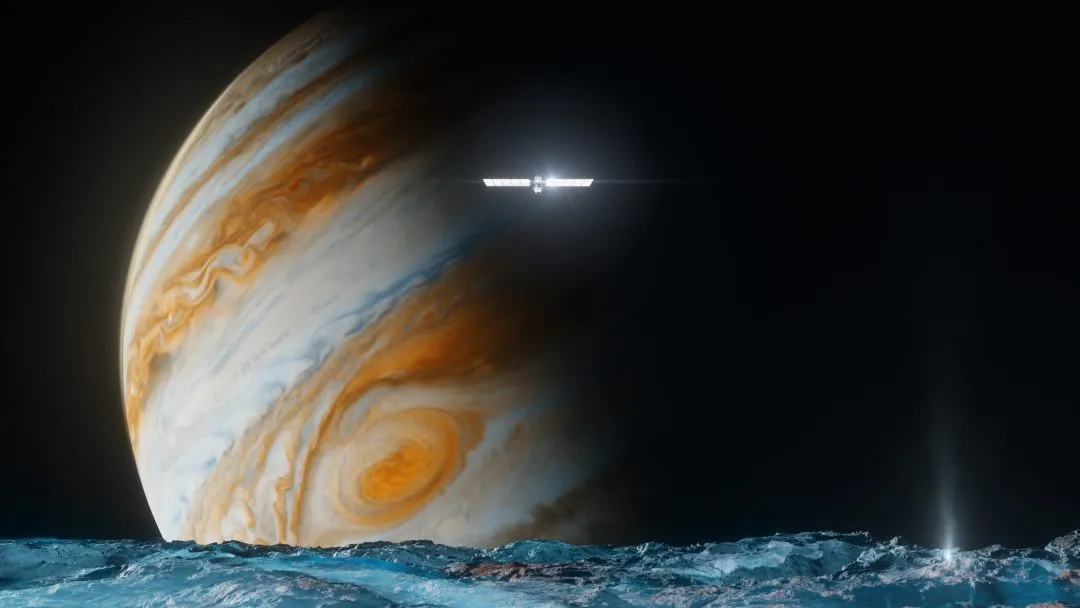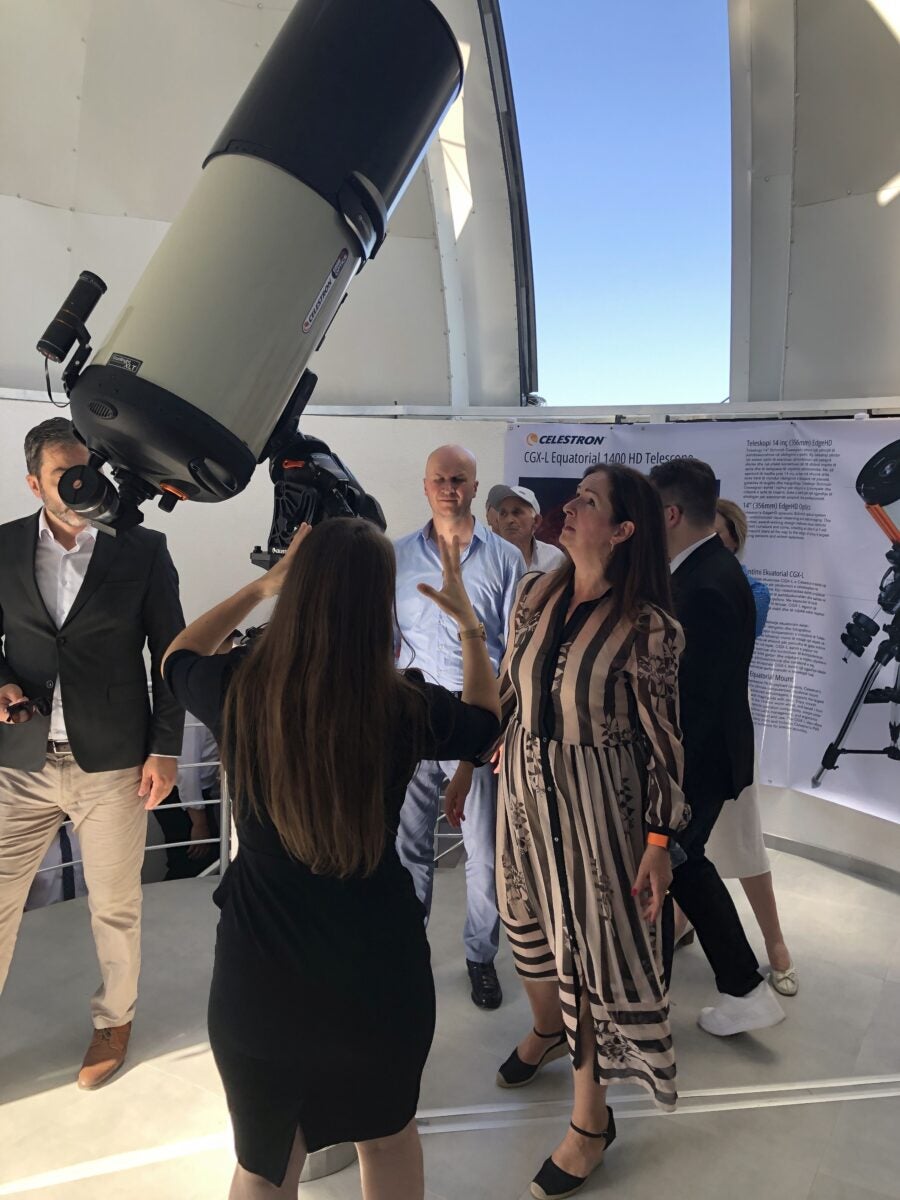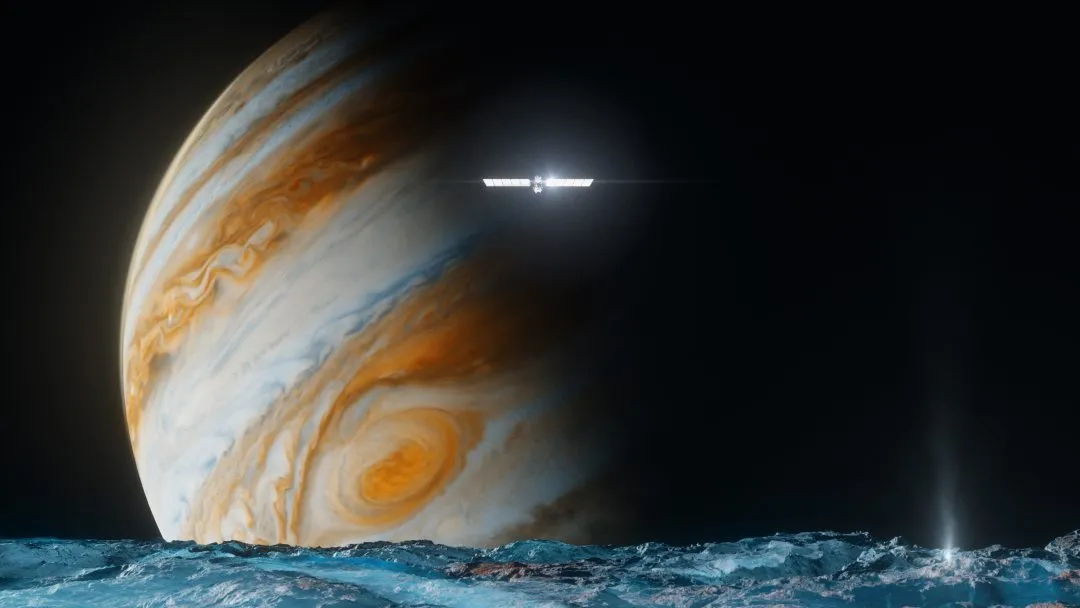
Europa Clipper flies above the icy surface of its eponymous moon in this artist’s concept. Credit: NASA/JPL-Caltech
NASA’s newest scientific flagship is on its way to the Jupiter system to explore the icy moon Europa, one of the most compelling worlds in our solar system.
The mission lifted off Oct. 14 from Launch Complex 39A at NASA’s Kennedy Space Center in Florida at 12:06 p.m. EDT aboard a SpaceX Falcon Heavy rocket. Roughly an hour later, the spacecraft separated from its launch vehicle, embarking on a cruise through the inner solar system. A pair of gravity assists will ultimately slingshot it to Jupiter. The spacecraft will travel some 1.8 billion miles (2.9 billion kilometers) over the next 5½ years and reach the Jupiter system in 2030.
Related: Europa Clipper launch postponed until at least Oct. 13 due to Hurricane Milton
Europa Clipper’s launch was originally scheduled for Oct. 10, but that was delayed by Hurricane Milton. The craft rode out the hurricane’s destructive trek across Florida the night of Oct. 9/10 safely ensconced in a hangar. After a damage assessment and recovery team surveyed the damage, Kennedy Space Center was declared safe and open, with only minor damage.
Enigmatic Europa
One of Jupiter’s four Galilean moons, Europa has long fascinated scientists. Some 90 percent the size of our own Moon, the satellite is believed to host a global ocean of liquid saltwater twice the volume Earth’s oceans, but locked beneath a water-ice crust some 2 to 20 miles (3 to 30 km) thick. Not only that, the moon is heated through tidal flexing as it orbits Jupiter on an elliptical path, and also contains the chemical building blocks of life as we know it.
All these factors combine to create a compelling world where Earth-like life might find a way. In fact, when people think of the potentially habitable places within our solar system, Europa likely tops the list.
It’s important to note, though, that “Europa Clipper is not specifically a life-search mission.” Instead, “we’re going to understand the potential habitability of Europa,” said Europa Clipper project scientist Robert Pappalardo in a NASA video. The mission will use nine instruments to study the moon’s interior and exterior, as well as the environment in which it sits, to learn about the ice shell and the ocean it hides, as well as the composition of the moon and whether it is geologically active.
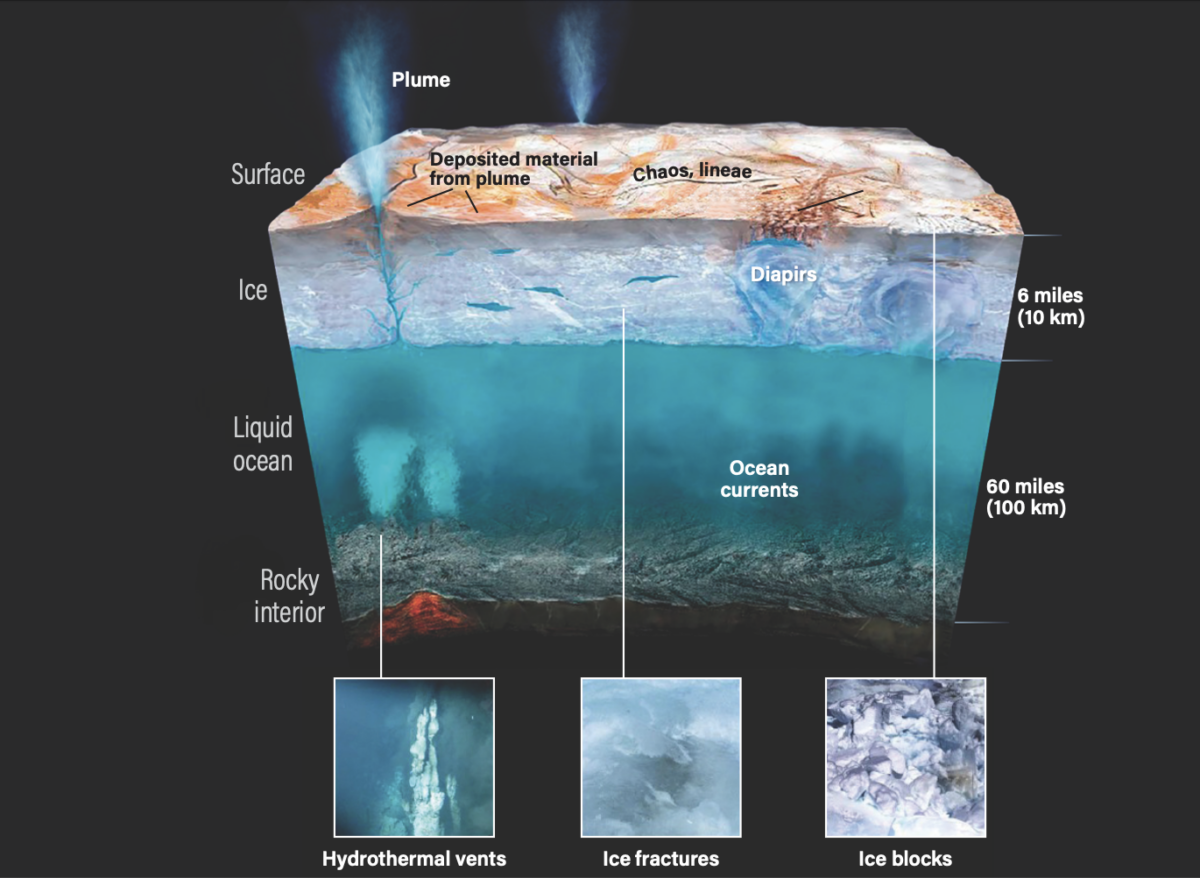
A dedicated mission
Once it launches, Europa Clipper will complete a triad of Jupiter missions currently in action, joining NASA’s Juno, which has been orbiting Jupiter since July 2016, and ESA’s JUpiter ICy moons Explorer (JUICE), which launched in April 2023 and is also on its way to the gas giant. In fact, Europa Clipper, currently scheduled to arrive at Jupiter in April 2030, will beat JUICE to its destination by about a year thanks to differing trajectories.
Related: JUICE spacecraft launches on mission to explore Jupiter’s icy moons
But why send Europa Clipper at all, if Juno is already in orbit and JUICE is on its way?
Juno is dedicated to studying Jupiter itself, although it’s certainly sent back some stunning imagery of the moons as well. Additionally, Juno’s mission is coming to a close, planned to end in September 2025. And after JUICE arrives in 2031, it will complete just two flybys of Europa in July 2032, before move on to concentrate the bulk of its mission on Ganymede and Callisto. Like Europa, these larger moons also presumably host liquid subsurface oceans, though farther beneath their own icy crusts.
Now, “for the first time ever, we’re sending a spacecraft completely dedicated to studying this moon,” said Tracy Drain, Europa Clipper’s lead flight system systems engineer.
Following its launch, Europa Clipper’s journey will take it past Mars (2025) and Earth (2026) for gravity assists before reaching the Jupiter system. Once there, it will use the Galilean moons to slow and shape its orbit, aiming to enter resonance with Europa’s orbit and make its first flyby of the eponymous moon in early 2031. Shortly after, in May that year, the craft will begin its science campaign, focusing first on the anti-Jupiter side of the moon (the side of Europa facing away from Jupiter).
A second science campaign, which will send the craft past the Jupiter-facing side of the moon, will begin in May 2033. In all, Europa Clipper will make 49 Europa flybys, each passing over different terrain as it builds up a nearly complete global map of the surface. At its closest, it will skim just 16 miles (25 km) above the surface.
Throughout these campaigns, the spacecraft will plunge into one of the worst environments imaginable, bathed by the intense radiation that surrounds Jupiter. The massive planet supports an extensive magnetosphere — the region of space where its magnetic field dominates. Charged particles from both the Sun and Jupiter itself, as well as from the highly volcanic moon Io, are trapped by the planet’s powerful magnetic field and generate huge, intense radiation belts — belts that encompass Io, Europa, and Ganymede, with the two innermost moons orbiting in the worst of it.
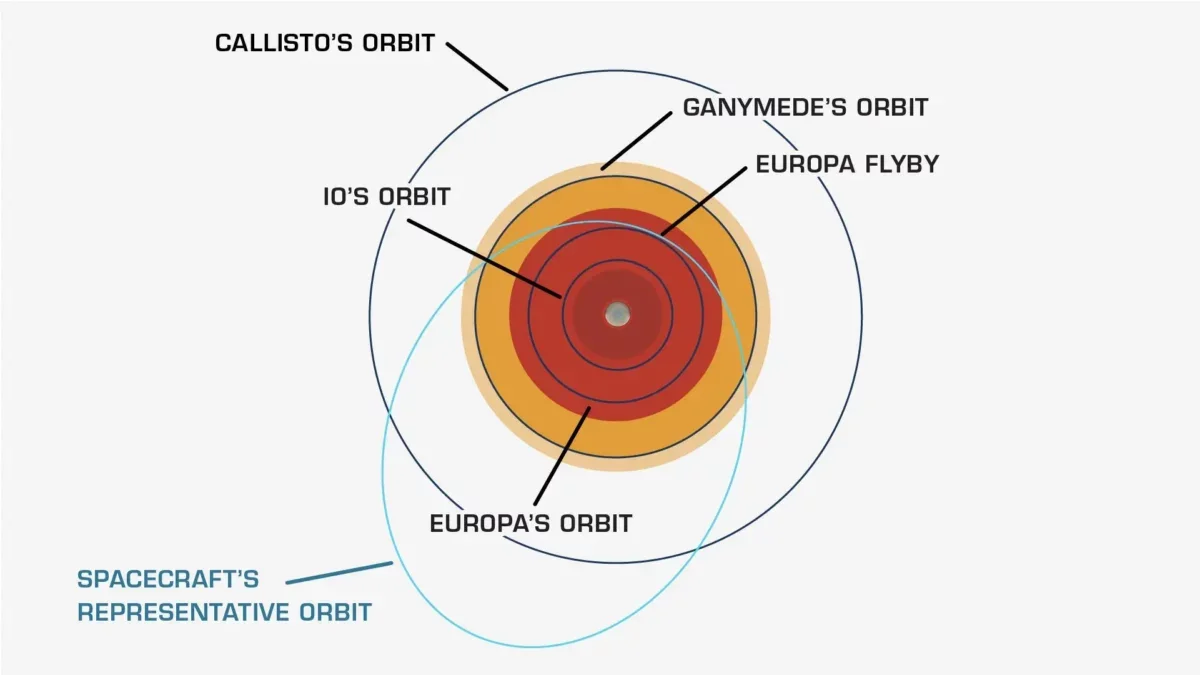
While there is no avoiding this environment if one wants to study Europa — and indeed, scientists think this unique environment has actively shaped Europa into the world we see today — the mission is taking precautions. First, the spacecraft will orbit Jupiter rather than Europa, meaning it will fly through — but not continually sit within — the worst of the radiation. Nonetheless, according to NASA, during each flyby, Europa Clipper will experience a dose of radiation equivalent to 1 million chest X-rays.
That’s why Europa Clipper is also taking a design note from Juno: The craft’s computer and sensitive electronics are locked within a sealed central vault, whose aluminum-zinc walls are some ⅓ inch (9.2 millimeters) thick. These walls will keep out enough of the punishing, fast-moving particle radiation to ensure the electronics within experience only “acceptable” levels of radiation and can function throughout the mission duration, according to NASA.
In May, however, engineers brought up concerns regarding the spacecraft’s transistors and their ability to withstand the high-radiation environment they were traveling to. It appeared that the parts might be less resistant to radiation than expected, and some would fail prematurely. However, additional testing ultimately bore out that the transistors would support the intended mission duration.
Additional specs
Europa Clipper is the largest NASA spacecraft ever built for a planetary mission. It weighs some 13,000 pounds (5,900 kilograms) and, with its two wide, winglike solar arrays extended, spans more than 100 feet (30.5 meters) — roughly the length of a basketball court.
The mission carries visible-light and infrared cameras, as well as ultraviolet and infrared spectrometers to measure composition. Its magnetometer and plasma instrument will measure the moon’s magnetic field (generated by its motion through Jupiter’s changing magnetic field). These observations will confirm the presence of a subsurface ocean, as well as measure its salinity, depth, and even the thickness of the ice shell above it. A radar instrument will also help map the surface, determine the thickness of the icy crust, and even pick up subsurface liquid to confirm the presence and depth of the ocean.
Gravity science experiments will allow astronomers to evaluate how Europa Clipper’s flight path changes as it is influenced by the moon’s gravitational environment, which changes as it orbits Jupiter. This will, in turn, reveal how much the moon’s shape changes due to tidal forces — a factor inherently tied to its internal structure.
Finally, the craft’s mass spectrometer and surface dust analyzer will explore the environment around the moon. In particular, they will analyze material vented by geysers, as well as surface ice particles knocked into space by micrometeorites. By studying the chemistry of Europa’s surface ice and subsurface water directly, scientists will be able to determine whether its ocean could indeed be hospitable to life.
Answers ahead
“All these worlds are yours — except Europa. Attempt no landing there,” reads the radio message beamed to Earth at the end of Arthur C. Clarke’s 2010: odyssey two. Although fueled by the presence of fictitious plantlike creatures beneath Europa’s surface, the sentiment behind the message rings true in real life. After a little less than a year and a half of science, Europa Clipper will end its mission in September 2034 with a “deorbit” into its fellow Galilean moon, Ganymede.
But Ganymede, like Europa, also harbors a subsurface ocean. So, why is it being targeted for the crash? According to the ESA, whose JUICE mission will also end by impacting Ganymede: “Icy moon Europa is the only object that is considered to have the potential for harboring life, and that therefore needs to be protected. … But as it stands, planetary protection rules allow a crash onto Ganymede, because there are no indications that the deep subsurface ocean on Ganymede can be in contact with the icy surface. Crashing into Europa would not be allowed because Europa’s subsurface oceans are suspected to be less deep and therefore contamination from the surface to the ocean would in theory be possible.”
Related: Why was Cassini crashed into Saturn?
Despite the mission’s brevity, Europa Clipper has the potential to unlock one of the most mysterious and enticing worlds in our solar system. And it will certainly bring us one step — or perhaps several steps — closer to answering the question of whether Earth is the only solar system world hospitable to life.
“This mission has been a long time coming, and we’re so excited about what we’re going to see when we get there,” said Pappalardo.
Editor’s note: This story was updated Oct. 15 to include information about Europa Clipper’s launch and the status of recovery efforts at Kennedy Space Center.
